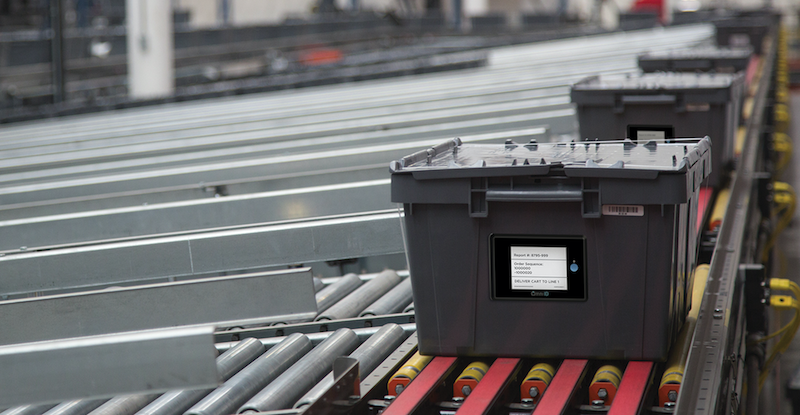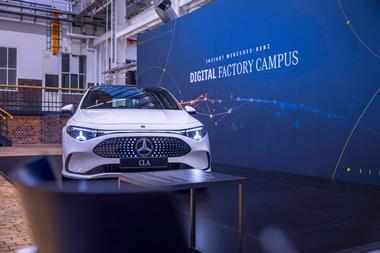
From the Internet of Things to Industry 4.0, manufacturing is changing. Paper labels no longer fit process complexities; what is required is optimal flexibility and quality assurance
 For 40 years, paper has been a trusted flag in manufacturing, providing sequential work instructions for operators. This simple visual cue has been the core of a process that balances production and creates more efficient just-in-time inventory. It may then be a surprise to many who work in the industry to find out that the static, paper-based, or kanban systems, which have been at the core of material flow management for decades, are also the number-one cause of factory inefficiency today.
For 40 years, paper has been a trusted flag in manufacturing, providing sequential work instructions for operators. This simple visual cue has been the core of a process that balances production and creates more efficient just-in-time inventory. It may then be a surprise to many who work in the industry to find out that the static, paper-based, or kanban systems, which have been at the core of material flow management for decades, are also the number-one cause of factory inefficiency today.
So, with technology and customisation trends expanding how do factories keep up? Despite the need to change, it’s easy to see why other systems have been unsuccessful in replacing traditional paper: it is simple, reliable, visual and familiar to the workforce.
However, it is also highly inflexible. Once the paper label is placed onto a container and launched into the process, its instructions or trajectory cannot be changed without significant human resources or costly manual work-arounds. Neither can it be tracked or communicate with robots or machines on the line. A next-generation system ideally needs all these attributes while still retaining the simplicity and reliability of paper.
Enter the IIoT and smart materialsThe Industrial Internet of Things (IIoT) has been a key driver to bring new interactive technologies to existing processes like material flow management. This demand for technology to make material ‘smart’ has resulted in an innovative combination of e-Paper, RF communication and simple business logic called ProVIEW.
In most factories, the scheduling team meets in the mornings to determine the demand for the day and create the jobs and output for the day. The schedule is committed to hundreds of paper labels with instructions upon them and manually affixed to the racks of materials for the day. But what if something goes wrong? Will you make the schedule for the day?
Instead, a wirelessly updated, e-paper ‘View’ tag can be placed on containers routing through the manufacturing process. Unlike paper, the location-aware tags change instructions along the route to tell operators what to do with them next and where to go if there are bottlenecks or other issues. These ‘smart materials’ also become immediately traceable in real time.
E-paper directly replaces the paper, fitting seamlessly into existing process with minimal to no training required for operators. This system is the first of its kind to provide paperless, wireless and interactive material flow management along with end-to-end process visibility.
Every rack, item and container on the factory floor is tracked by its location, state and condition – which can be dynamically changed at any time to accommodate a work flow change. Repurposing some material for another part of the line or staging it to balance flow? No problem. Machine is down and material needs to be re-routed to optimise output? ProVIEW can take care of that.
See how Daimler Trucks and others are using ProVIEW to optimise their Material Flow Management processes at www.omni-id.com/AMS
![]()
Common issues that are being solved today using the ProVIEW systemIssue: Rescheduling/reassigning routes for work in process (WIP)When bottlenecks occur, it is prohibitively expensive for racks to be tracked down and new labels applied – or operators compensate by ignoring the instructions on the label to bypass issues. The result is chaos on the factory floor.Resolution: Using existing systems to know what machines and operators are available and instantly use this information to send a message to the View tags to create optimised routing for each rack or smart container.
Issue: Out-of-sequence container or rack deliveryParts are often hard to distinguish from one another – if installed in the wrong sequence it can destroy the value of an entire batch. This could result in a costly write-off of the entire WIP.Resolution: Each view tag ensures that its rack or container is associated to a specific work process. If it arrives out of order, it automatically signals the operator with a message indicating that they should not use the materials as they have arrived out of order.
Issue: Updating build instructions for WIPUpdating build instructions, especially during the production process, is difficult. For instance, if tooling is serviced or updated at any given station, an extra QA step must be added to qualify the new tool.Resolution: Build instructions are easily changed in real time with the ProVIEW system to accommodate for quality or process changes. The view tags are equipped with buttons to provide a means for the operator to indicate that the QA has been done and is automatically notated to the system.
Issue: Reconfiguring pick areasSetting up to enable optimal picking when a new job is put to the floor can take a week or two depending on the installation of shelves, racks, configuring or even coding the picking software to match the setup. With changes happening more and more often, this wasted time is becoming significant in the overall efficiency.Resolution: Wireless view tags make it easy to swap out parts or reset a pick area. View tags can be quickly mounted where they are needed with simple Velcro tape or snap-in brackets. What took a week can literally take an hour, making multiple changeovers possible for competitive advantage.
“ProVIEW’s Pick Application reduced our average pick times from 47.5 to 29.2 seconds and our accuracy on quantity and sequence was dramatically better with the visual instructions right at the point of picking. Most impressive for us is the ease of use of the system. New workers could jump in and be effective immediately because of the easy visual cues and instructions.
“Setting up a new picking cell when we reconfigured lines used to take more than a week. Using the wireless tags and simple software, last month we did a changeover in two hours using just the line operators (no IT team needed). Based on this success, we’ve added the replenishment application and are looking at full container management as well.”– Plant managertier one automotive supplier





































